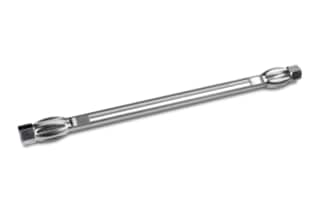
|
Chemistry |
Phenyl |
|
Separation Mode |
Reversed Phase |
|
Particle Substrate |
Hybrid |
|
pH Range Min |
1 pH |
|
pH Range Max |
12 pH |
|
Maximum Pressure |
6000 psi (415 Bar) |
|
Endcapped |
Yes |
|
Bonding Technology |
2-methyl-2-phenylethyl |
|
Silanol Activity |
Low |
|
Particle Shape |
Spherical |
|
Particle Size |
3.5 µm |
|
Endfitting Type |
Waters |
|
Pore Size |
125 Å |
|
Format |
Column |
|
Surface Area |
175 |
|
System |
HPLC |
|
USP Classification |
L11 |
|
Inner Diameter |
3 mm |
|
Length |
150 mm |
|
Carbon Load |
12 % |
|
UNSPSC |
41115709 |
|
Brand |
XTerra |
|
Product Type |
Columns |
|
Units per Package |
1 pk |

XTerra Phenyl Column, 125Å, 3.5 µm, 3 mm X 150 mm, 1/pk
The packing materials used in the XTerra Phenyl Column are created using Waters Hybrid Particle Technology. The XTerra particles are made up of both inorganic (silica) and organic (organosiloxane) components, giving them the best of both worlds. This Hybrid approach outperforms Silica-based reversed-phase packing materials in terms of separation efficiency and pH stability. XTerra Columns are made using ultrapure reagents to control the chemical composition and purity of the Hybrid particle. Every manufacturing step is conducted within tight tolerances, and each column is tested independently. Each column comes with Batch Analysis and Column Efficiency certificates.
The XTerra Phenyl Column is a significant piece of laboratory equipment that can provide further selectivity to straight-chain alkyl stationary phases, especially for compounds with aromatic rings. It also has excellent peak shape for all compounds, exceptionally reproducible retention lengths, strong pH stability, and excellent surface coverage. This is possible because of the powerful combination of Hybrid Particle Technology and Xterra phenyl chemistry, which results in a novel stationary phase with these outstanding features. Furthermore, the difunctional bonding chemistry of the XTerra Phenyl Column's short-chain phenyl ligand improves the column's low pH hydrolytic stability. This unique substrate and ligand add a new level of selectivity to complex mixture separations.
The XTerra Phenyl Column is a reversed-phase hybrid column with phenyl ligand functionality that should be in your lab equipment collection. These first-generation Xterra columns outperform silica-based columns in terms of pH stability. The Xterra Columns are available in a variety of porosity and particle sizes to meet your chromatographic requirements. You may find out more about them in our catalog or on our website, and you can also shop for lab equipment through either medium.
You may also be interested in LCMS Certified Clear Glass 12 x 32 mm Screw Neck Vial, with Cap and Preslit PTFE/Silicone Septum, 2 mL Volume, 100/pk; All Waters LCMS Certified vials are manufactured using stringent manufacturing and handling methods. They are mass spectrometer tested and come with a certificate of analysis displaying the reference and vial scan for the production batch.
What Do Quaternary Amines Refer To?
A quaternary amine refers to an amine salt featuring a positively charged nitrogen atom connected to four groups. These positively charged surface-active compounds, also known as cationic surfactants, readily bind to the negatively charged surfaces of numerous microorganisms. Their effectiveness as disinfectants and cleaning agents finds applications across various sectors.